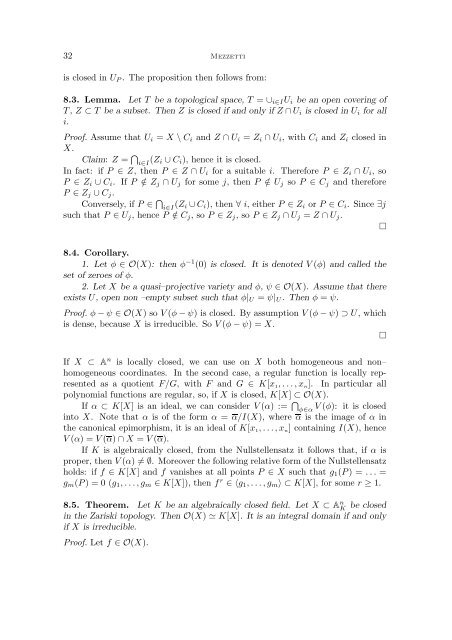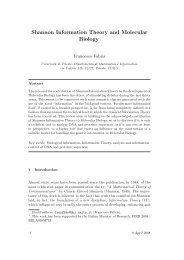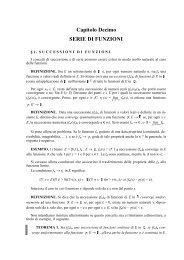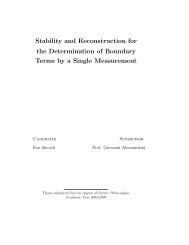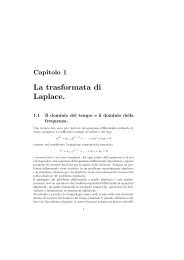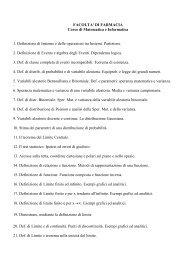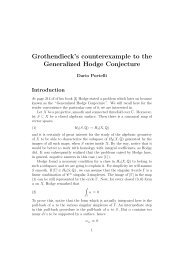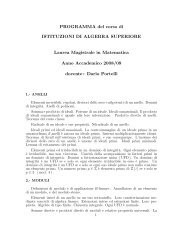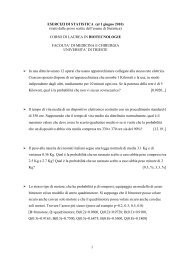INTRODUCTION TO ALGEBRAIC GEOMETRY Note del corso di ...
INTRODUCTION TO ALGEBRAIC GEOMETRY Note del corso di ...
INTRODUCTION TO ALGEBRAIC GEOMETRY Note del corso di ...
You also want an ePaper? Increase the reach of your titles
YUMPU automatically turns print PDFs into web optimized ePapers that Google loves.
32 Mezzettiis closed in U P . The proposition then follows from:8.3. Lemma. Let T be a topological space, T = ∪ i∈I U i be an open covering ofT, Z ⊂ T be a subset. Then Z is closed if and only if Z ∩ U i is closed in U i for alli.Proof. Assume that U i = X \ C i and Z ∩ U i = Z i ∩ U i , with C i and Z i closed inX.Claim: Z = ⋂ i∈I (Z i ∪ C i ), hence it is closed.In fact: if P ∈ Z, then P ∈ Z ∩ U i for a suitable i. Therefore P ∈ Z i ∩ U i , soP ∈ Z i ∪ C i . If P /∈ Z j ∩ U j for some j, then P /∈ U j so P ∈ C j and thereforeP ∈ Z j ∪ C j .Conversely, if P ∈ ⋂ i∈I (Z i ∪ C i ), then ∀ i, either P ∈ Z i or P ∈ C i . Since ∃jsuch that P ∈ U j , hence P /∈ C j , so P ∈ Z j , so P ∈ Z j ∩ U j = Z ∩ U j .□8.4. Corollary.1. Let φ ∈ O(X): then φ −1 (0) is closed. It is denoted V (φ) and called theset of zeroes of φ.2. Let X be a quasi–projective variety and φ, ψ ∈ O(X). Assume that thereexists U, open non –empty subset such that φ| U = ψ| U . Then φ = ψ.Proof. φ − ψ ∈ O(X) so V (φ − ψ) is closed. By assumption V (φ − ψ) ⊃ U, whichis dense, because X is irreducible. So V (φ − ψ) = X.□If X ⊂ A n is locally closed, we can use on X both homogeneous and non–homogeneous coor<strong>di</strong>nates. In the second case, a regular function is locally representedas a quotient F/G, with F and G ∈ K[x 1 , . . ., x n ]. In particular allpolynomial functions are regular, so, if X is closed, K[X] ⊂ O(X).If α ⊂ K[X] is an ideal, we can consider V (α) := ⋂ φ∈αV (φ): it is close<strong>di</strong>nto X. <strong>Note</strong> that α is of the form α = α/I(X), where α is the image of α inthe canonical epimorphism, it is an ideal of K[x 1 , . . ., x n ] containing I(X), henceV (α) = V (α) ∩ X = V (α).If K is algebraically closed, from the Nullstellensatz it follows that, if α isproper, then V (α) ≠ ∅. Moreover the following relative form of the Nullstellensatzholds: if f ∈ K[X] and f vanishes at all points P ∈ X such that g 1 (P) = . . . =g m (P) = 0 (g 1 , . . ., g m ∈ K[X]), then f r ∈ 〈g 1 , . . ., g m 〉 ⊂ K[X], for some r ≥ 1.8.5. Theorem. Let K be an algebraically closed field. Let X ⊂ A n K be close<strong>di</strong>n the Zariski topology. Then O(X) ≃ K[X]. It is an integral domain if and onlyif X is irreducible.Proof. Let f ∈ O(X).


